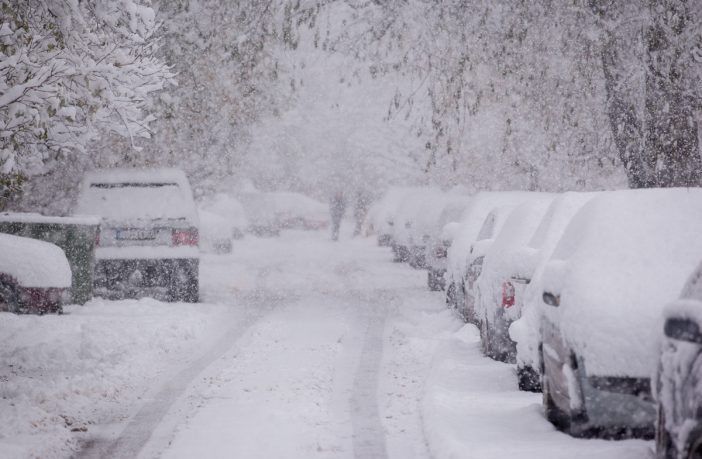Governor Kathy Hochul today warned New Yorkers of potentially hazardous conditions due to wintry weather during the busiest day of the year for travel. A storm system will impact areas in the North Country, Capital District, and Central NY beginning late Tuesday and continuing through Wednesday with rain, snow and freezing rain or sleet in some locations, while other locations around the state, especially the New York City area, should see mostly rain. Areas in the North Country and at higher elevations are forecast to receive snow or a rain/snow mix on Tuesday evening before changing over to plain rain by Wednesday morning. Minor snow and ice accumulations will likely result in hazardous travel conditions, especially during the overnight and early morning hours, until temperatures warm on Wednesday morning. Winds are also expected to be gusty statewide with some gusts up to 35 mph in some places, especially Western NY, the North Country, and the New York City area.
“We are watching a storm system that could cause slippery conditions on roadways during the busiest travel day of the year, and I encourage New Yorkers to plan accordingly,” Governor Hochul said. “While this state is no stranger to winter weather, it is always better to be prepared than to find yourself stranded or stuck. New York State agencies are prepared to assist local communities as needed and we will continue to monitor the forecast.”
The storm system is expected to arrive Tuesday evening with precipitation beginning as a rain/snow mix in several locations. Most valley areas should see a quick change to all rain while areas in the North Country and especially high terrain areas may see snow through the night. There is a possibility of sleet or freezing rain in the higher terrain of the Adirondacks. Winds will be gusty statewide on Tuesday night with some gusts up to 35 mph. For a complete listing of weather alerts and forecasts, visit the National Weather Service website at https://alerts.weather.gov. New Yorkers are encouraged to sign up for emergency alerts by subscribing to NY Alert at https://alert.ny.gov, a free service providing critical emergency information to your cell phone or computer.
Agency Preparations
New York State Division of Homeland Security and Emergency Services
The Division is actively monitoring the weather forecast and coordinating the State’s response to the weather event. Office of Emergency Management staff are in contact with local counterparts and are prepared to facilitate requests for assistance.
The Division is prepared to deploy the following assets and shelter supplies from the State’s stockpiles, if necessary:
- 1,489 generators
- 536 chainsaws
- 964 portable heaters
- 39,948 MREs
- 552,260 bottles & cans of water
- 9,105 cots
- 9,641 blankets
- 11,220 pillows
New York State Department of Transportation
The State Department of Transportation is prepared to respond with 3,559 supervisors and operators available statewide. Regional crews are currently engaged in snow and ice preparations. Regional managers are evaluating pavement conditions in advance of the precipitation and will be applying brine pre-treatment as appropriate. All residency locations will remain staffed for 24/7 operation throughout the duration of the event and priority cleanup operations. HELP truck beats will be extended in impacted areas. The need for staff deployments will be continually re-evaluated throughout the event.
Transportation Management Centers in affected regions will be posting weather-related messages starting Monday afternoon in Western NY and Tuesday morning in all other locations. Messaging will also be used to support real time incidents and vehicle restrictions, if necessary.
All available snow and ice equipment is ready to deploy. Fleet mechanics in affected areas will be staffing all main residency locations 24/7 to perform repairs and keep trucks on the road. Statewide equipment numbers are as follows:
- 1,601 large plow trucks
- 150 medium duty plows
- 51 tow plows
- 331 large loaders
- 35 snow blowers
For real-time travel information, motorists should call 511 or visit https://www.511ny.org or the mobile site at m.511ny.org, New York State’s official traffic and travel information source.
Thruway Authority
The Thruway Authority is ready to respond with 677 operators and supervisors available. Statewide equipment numbers and resources are listed below:
- 350 large and medium duty plow trucks
- 10 tow plows
- 65 loaders
- More than 130,000 tons of salt on hand
Variable Message Signs and social media are utilized to alert motorists of winter weather conditions on the Thruway.
The Thruway Authority encourages motorists to download its mobile app which is available for free on iPhone and Android devices. The app provides motorists direct access to real-time traffic information, live traffic cameras, and navigation assistance while on the go. Motorists can also sign up for TRANSalert e-mails which provide the latest traffic conditions along the Thruway.
New York State Department of Public Service
Utility companies regulated by the Department of Public Service have approximately 5,500 workers available statewide to engage in repair and restoration efforts for the winter weather system. DPS staff will track utilities’ work throughout the event and ensure utility companies shift appropriate staffing to regions that experience the greatest impact. If your service is interrupted, visit the DPS Utility Service Interruptions website for tips.
New York State Police
State Police are monitoring weather conditions and are prepared to deploy additional Troopers as needed. All State Police four-wheel drive and specialized vehicles, including snowmobiles and utility terrain vehicles, are staged and ready for immediate response, and all emergency power and communications equipment has been tested.
New York State Department of Environmental Conservation
DEC Emergency Management staff, Environmental Conservation Police Officers, Forest Rangers, and regional staff are on alert and monitoring the developing situation. All available assets are positioned to assist with any emergency response.
Winter hiking safety and preparedness are extremely important regardless of a hiker’s physical ability or destination. Properly preparing for winter conditions is essential for a more enjoyable and safer experience. Additional information on winter hiking is available at https://www.dec.ny.gov/outdoor/112826.html.
New York State Office of Parks, Recreation and Historic Preservation
New York State Park Police and park personnel are on alert and closely monitoring weather conditions and impacts. Response equipment is being fueled, tested, and prepared for storm response use. Park visitors should check parks.ny.gov or call their local park office for the latest updates regarding park hours, openings, and closings.
Safety Tips
Travel
Some of the most important tips for safe driving include:
- Do not drive unless necessary.
- If you must travel, make sure your car is stocked with survival gear like blankets, a shovel, flashlight and extra batteries, extra warm clothing, set of tire chains, battery booster cables, quick energy foods and brightly colored cloth to use as a distress flag.
- If you have a cell phone or other communications device such as a two-way radio available for your use, keep the battery charged and keep it with you whenever traveling. If you should become stranded, you will be able to call for help, advising rescuers of your location.
- The leading cause of death and injuries during winter storms is transportation accidents. Before getting behind the wheel, make sure that your vehicle is clear of ice and snow; good vision is key to good driving. Plan your stops and keep more distance between cars. Be extra alert and remember that snowdrifts can hide smaller children. Always match your speed to the road and weather conditions.
- It is important for motorists on all roads to note that snowplows travel at speeds up to 35 mph, which in many cases is lower than the posted speed limit, to ensure that salt being dispersed stays in the driving lanes and does not scatter off the roadways. Oftentimes on interstate highways, snowplows will operate side by side, as this is the most efficient and safe way to clear several lanes at one time.
- Motorists and pedestrians should also keep in mind that snowplow drivers have limited lines of sight, and the size and weight of snowplows can make it very difficult to maneuver and stop quickly. Snow blowing from behind the plow can severely reduce visibility or cause whiteout conditions. Motorists should not attempt to pass snowplows or follow too closely. The safest place for motorists to drive is well behind the snowplows where the roadway is clear and salted. Never attempt to pass a snowplow while its operating.
Power Outages
- Check with your utility to determine area repair schedules.
- Turn off or unplug lights and appliances to prevent a circuit overload when service is restored; leave one light on to indicate when power has been restored.
- If heat goes out during a winter storm, keep warm by closing off rooms you do not need.
- To Report an Electric Outage, Call:
- Central Hudson: 800-527-2714
- Con Edison: 800-752-6633
- National Grid: 800-867-5222
- NYSEG: 800-572-1131
- O&R: 877-434-4100
- PSEG-LI: 800-490-0075
- RG&E: 800-743-1701
Heating Safety
- Use only safe sources of alternative heat such as a fireplace, small well-vented wood or coal stove or portable space heaters.
- When using alternative heat sources such as a fireplace, woodstove, etc. always make sure you have proper ventilation. Always follow manufacturer’s instructions.
- Keep curtains, towels, and potholders away from hot surfaces.
- Have a fire extinguisher and smoke detectors and make sure they work.
- If you use kerosene heaters to supplement your regular heating fuel, or as an emergency source of heat, follow these safety tips:
- Follow the manufacturers’ instructions.
- Use only the correct fuel for your unit.
- Refuel outdoors only and only when the unit is cool.
- Keep the heater at least three feet away from furniture and other flammable objects.
- When using the heater, use fire safeguards and ventilate properly.
For more winter safety tips, visit https://dhses.ny.gov/safety. For all non-emergency service needs in New York State before, during or after a storm, call 211 or visit 211nys.org.
About the Division of Homeland Security and Emergency Services
The Division of Homeland Security and Emergency Services (DHSES) provides leadership, coordination, and support to prevent, protect against, prepare for, respond to, recover from, and mitigate disasters and other emergencies. For more information, follow @NYSDHSES on Facebook, Instagram, and X (formerly known as Twitter) or visit dhses.ny.gov.













